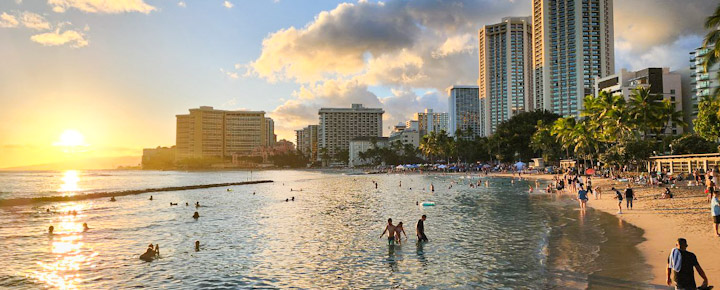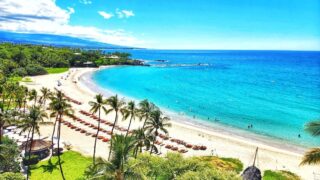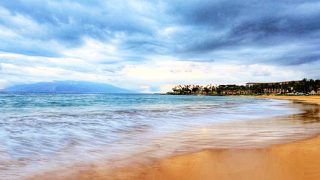Europe is now on par with Hawaii in terms of both travel costs and the implementation of plans to limit the impact of mass tourism. This comes primarily from an influx of American tourists, who have moved from Hawaii-centric travelers to Europe-centric travelers over the past year.
American visitors this summer are packing in everywhere from London and Paris to Rome and Greece, and countless other popular European destinations. At the same time, here in Hawaii, we’re in the early part of a slowing trend of Hawaii visitors. Beat of Hawaii is traveling throughout Hawaii this summer as well as to Europe and will continue to bring you tourism updates and contrasts.
All-time high tourism hits Europe as Hawaii remains somewhat muted for now.
We’ve heard that visitors can now have to wait for hours to gain access to Athens’ famed Acropolis. Lines to enter the Louvre in Paris, or to get taxis in Europe’s major cities, are equally long and frustrating. We saw unfathomable crowds in London earlier this summer; from what we hear, it has only worsened.
In Hawaii, on the other hand, there are fewer tourists. Regular commenter Kauaidoug said recently in that regard:
“Aloha, editors. I am either in the Waimea Canyon state park or Kauai’s North Shore at least 5 times a month and I can tell you I’m still waiting on the usual summer influx of visitors. I actually got a parking place at black pot beach in the middle of the day! I kept thinking the crowds will surely start after July 4 but no. Americans are going places they couldn’t for the last 3 years, but I am confident people will be back… Prices in Hawaii will moderate by next year and we’ll all be happier.”


Beach destinations remain at or near the top of everyone’s list.
Whether Hawaii, the Greek Islands, the Italian coastline, Barcelona, or other coastal regions in Spain, these are among the most in-demand destinations. Many of the visitors who flooded Hawaii last year seem to have arrived squarely at beaches on the European continent instead.
Visitors don’t seem fazed by crowds or skyrocketing hotel and airfare costs.
Recently, we were helping a friend find airfare from Hawaii to Europe, and the lowest available prices for round-trip economy airfares we found were still $2,300. Beat of Hawaii is also sending editors to Europe this summer to compare what’s happening here in the Hawaiian Islands vs. on the European continent. We have found that up until this spring, Europe still had better deals to offer in the area of both accommodation and airfare, but now those are largely gone.
For example, BOH editors will be traveling about 300 miles on a popular European route. That’s just slightly farther than say, flying between Kauai and the Big Island, but the cost for a one-way ticket in economy is more than $500 per person, rather than the $39 or $59 we are finding here.
So even though we recently paid Southwest $600 for a one-way economy ticket between Hawaii and the mainland, it is getting harder to complain or to see Hawaii airfares as something out of the ordinary.
Hawaii and Europe: reigning in run-away revenge tourism.
While Hawaii seems to be throwing every possible control at the wall to see what sticks, Europe, at least appears to be taking a more measured and well-thought-through approach.
In Europe overall, pending and planned regulations come as Italy, for example, sees record numbers of arrivals at all of its must-see spots, including the major cities like Venice, Rome, and Florence, as well as in beach spots like Capri. Rome has been hard hit by a massive influx of tourists this year, and tourists have defaced the Colosseum multiple times this summer. New rules putting the brakes on vacation rentals are on the way for Italy, and have already taken effect in Florence, while other cities are watching to see how that unfolds as they plan for national regulation of Airbnb and other vacation rentals. France has instituted measures to help manage tourism at its national parks.
A noticeable change in some visitors’ attitudes has been seen in Hawaii since Covid. While not pervasive by any means, there are clearly changes not for the better. In the air, this has taken the form of an unending number of Hawaii flight diversions caused by unruly passengers. Is that improving? Not that we can see.
We can’t help but mention some visitors’ disregard for turtles on the beach and Hawaiian Monk Seals. Some will try to go to any lengths to get the perfect Instagram photograph, often violating state and federal laws.
Hawaii and European destinations are joining in a desire to find new paths where tourism provides more significant benefits for visitors and residents while doing less harm overall.
Hawaii tourism controls.
You’ll recall that the on-lifeline Hawaii Tourism Authority (HTA), recently saved at least for now from elimination, launched a new website earlier this year called “Holomua” to keep all of us up to date on each island’s community-based Destination Management Action Plans (DMAPs). These plans are the roadmap of Hawaii’s efforts to balance the benefits and impact of tourism in relation to natural resources and over-visited areas. Holomua (meaning progress) is a collection of reports, stories, updates on each island, and information about regenerative tourism, culture, visitor education, and more. The goal, per HTA, is “to better manage tourism.” Details are short but the direction is clear.
Hawaii green fees are on hold for now.
The proposed “green fees” have been sidelined, probably just temporarily, failing to make it through this year’s legislature. The governor has vowed to bring it back next year. The goal was, in part, to use funds to help preserve Hawaii’s natural resources. Initially promoted by Josh Green as a blanket fee for all visitors, it became a fee charged only to Hawaii visitors using state resources, such as state beaches, parks, and trails. While such a fee is off the table for now, it could well return. In any event, implementation of any such fees will be postponed until sometime near the end of the decade.
Rules at Hanauma Bay Nature Preserve and Haena State Park are examples.
At Haena State Park on Kauai, the plan, which requires difficult-to-obtain visitor reservations for entry and parking, is touted as a model for deployment statewide. Not only that, but it remains possible if not likely that further visitor restrictions in accessing Kauai’s North Shore beaches from Hanalei Bay to Kee Beach will occur. Those have already been proposed.
Parking and visitor reservations for Haena State Park (including Kee Beach and the Kalalau trail) must be made 30 days before arrival. Comments have indicated that these are nearly impossible to obtain. Visitors without permits can use Haena Beach, which is before the restricted area. However, because of overcrowding and limited facilities, one proposal suggests bringing county parks at Haena Beach and Tunnels Beach into the Haena State Park system to reduce non-permitted visitor traffic.
At Oahu’s beloved Hanauma Bay Nature Reserve, a $25 per person, timed entry permitting system for out-of-state visitors has been in effect since 2021. They require reservations to be made up to 48 hours in advance, and the viewing of a mandatory introductory video before entry.
“Not encouraging” visitors to Waikiki, Diamond Head, Poipu etc.?
You’ll recall a release by HTA earlier this year, which suggested, among other things, that HTA “Does Not Encourage Visiting:” Waikiki, Diamond Head, Volcanoes, Poipu, Etc.” That HTA Ma’ema’e Toolkit was signed by the state tourism agency’s next departing head. As we have said, “Hawaii lawmakers are looking at entirely eliminating the Hawaii Tourism Authority.” That hasn not happened thus far, but we are certain that we have not heard the end of it either.
European residents, as in Hawaii, find it all but impossible to access their own resources.
There is a widespread tourism-reform movement developing. We’ve heard much about anti-visitor sentiment in Barcelona, among many other places. In Greece, the country is just slightly shy of its record of 34 M visitors in 2019. But even now, new measures are being planned or implemented to help control tourism.
At the Acropolis in Athens, for example, the government has implemented a ticketing system for visitor entry. While in Spain, which is breaking all prior records this year, Hawaii-high prices could become a bit of a self-regulating factor. BOH editors found booking for this summer in Spain to be extremely expensive, far higher than ever before.
Tourist expenses skyrocket in Europe.
Italy’s hotel association reported earlier this year that US visitor spending is up 74% compared with 2019.
They bring a lot of pent-up buying power: U.S. tourists in Italy spent 74% more in tax-free indulgences in the first three months of the year compared with the same period in 2019. Primarily due to extreme costs, inter-European, more cost-conscious tourism is lower than it was in 2019. It has also been reported that accommodation costs in Italy are up by 53% in Florence, 25% in Venice, and 21% in Rome.
Some blame the huge number of visitors on the short-term vacation rental sector.
In Florence, there will be at most 8,000 vacation rentals permitted. Other places like Venice have yet to act but are watching closely to see the outcome of Florence’s plans. That city may be the next to act, given that it already has as many visitors as residents at any moment in time, a situation that continues to worsen.
Residents say that they cannot access streets and waterways due to over-tourism. Venice has been planning to institute a charge for city visitors to help mitigate the effects of the worst tourism they’ve ever experienced. The analogy to Disneyland, which we’ve often seen used regarding Hawaii tourism, is frequently made about Venice.
Clearly, more controls on short-term rentals are in the works globally.
Can Hawaii learn from our European counterparts?
Should tourism be constrained to keep it from overwhelming and destroying the local quality of life? Or should the residents simply be grateful for all of the dollars being doled out by the unending hordes of visitors?
Get Breaking Hawaii Travel News







For the beaches like Kee, they need to do batches released in advance and again like a day or two out for weather and surf dependent activities. Some people want to sit on the beach, some want to snorkel, or surf, or hike… some would care about rain and some wouldn’t.
The and any disregard for turtles on the beach and Hawaiian Monk Seals is unacceptable. I wish those that are caught woule be fined and not afraid to offend the tourists for any reason on misbehavior. I came to the Islands in the early 70’s and many just like me were only coming to visit because of the love of nature, beauty and the loving people with Aloha. The selfie, social media has and is destroying this world. We can do better, by raising our children. Not letting the (kiddos) raise us. Respect starts within the home.
My My how things have changed and contuie to change. Just a few months ago I recall reading articles about the inflated cost to visit Hawaii with no real end insight.
Now with a down turn in the market and fewer people coming. Discounts are starting to come back on Hotels and Condo Rentals airfares and even car rentals.
Tom T,
We, humans, seem to think tomorrow = yesterday, never looking back and realizing change is inevitable.
When imbalance occurs, it will always be corrected. Perhaps not always perfectly, but corrected nonetheless.
Unfortunately, I paid for my September tickets with miles and haven’t seen any change.
First trip, 1 day, courtesy of the USMC and virtually every year since the mid 1970s. Three years ago we thought it was our last. But, still going strong as 80 is just around the corner.
But, today, my wife and I leave for San Diego for a week with my daughter, 2 grandsons and ex-wife. They flew in this morning. Daughter’s hubby is in the Army and will stay behind in Texas. Other than spending time with my family, I’m not looking forward to a week in San Diego.
Aloha
A very difficult issue that tugs at my heart. I first visited Kauai in 1975 and made lifelong friends with a few folks. When hurricane Iwa hit in late ’81, some friends reached out to me and said, there is so much work to repair the damage that I could come over and start working immediately. I came and didn’t leave until late ’86. I remember how peaceful and serene the island was back then. Like everywhere, things always change. If they had limited the amount of hotels, condos, etc. that were permitted to be built since the 80’s, we would be in a better place. But, as we know, the almighty dollar won out. I now visit yearly, and have been for the past 20+ years. I stay for a minimum of 5 weeks and as long as 10 weeks. I agree that something needs to be done to save the islands from overuse. I think if there was a limit to the amount of short stay rentals, even at hotels, then that could be a way to keep numbers down. I believe the long term visitors return because they love the islands and show a lot more respect for the land and resources. I hope I can afford to still come to my adopted home until the day I can no longer stand and walk.
I hate the restrictions and costs. They hurt one group more than others – those who save for years for that one trip to places like Hawaii and Europe. I guess the way it is in most things – those with the fewest resources get hosed.
If there’s a lot of revenge vacationing now, cities better watch out when the urge is gone.
I find it interesting that you only mention Hawai’i and Europe. I too find the fees they charge to non residents very unfair. I feel that a lot of places throughout the country are experiencing this same type influx of travelers. I live in Utah and know that the National Parks in our state are some of the busiest in the country and the same could be said about our Ski Resorts. It’s hard to enjoy the things in your own state when tourists are crowding your own back yard. We have a lot of hiking, winter and summer outdoor activities, and water activities in our state. There is a lot of similarities with Utah and Hawai’i landscapes less the ocean. Unfortunately I think we live in a time where travel has become a big part of everyone’s lives. We don’t get special treatment for living in Utah at our state parks, we don’t get discounts, we get special days to ourselves, and we don’t charge tourists more money to come to see our beautiful landscape. I understand that people would like to keep the land beautiful for everyone, but it should be shared between locals and tourists alike.